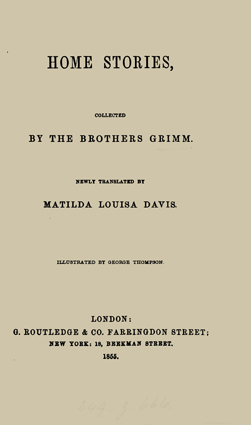“Red Riding Hood” – „Rotkäppchen“– “Little Red Cap”
Wechselwirkung im deutschen und im englischsprachigen Kulturraum
Bereits 1729 erschien die erste Übersetzung von „Chaperon Rouge“ ins Englische.
HISTORIES,/ OR/ TALES of past Times:/ […]./ With MORALS./ By M. PERRAULT./ Translated into English./ LONDON:/ Printed for J. POTE, at Sir Isaac New-ten’s Head, near Suffolk-street, Charing-cross; and R. MONTAGU, the Corner of Great Queen-street, near Drury-lane./ M.DCC.XXIX.
THE/ Little red Riding-Hood./ TALE I., S. 1-8.
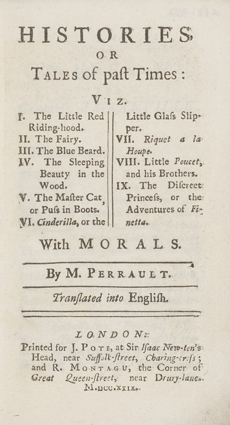
THE Little red Riding-Hood.
TALE I.
HERE was once upon a time a little country girl, born in a village, the prettiest little creature that ever was seen. Her mother was beyond reason excessively fond of her, and her grandmother yet much more. This good woman caused to be made for her a little red Riding-Hood; which made her look so very pretty, that every body call'd her, The little red Riding-Hood.
ONE day, her mother having made some custards, said to her, Go my little Biddy, for her christian name was Biddy, go and see how your grandmother does, for I hear she has been very ill, carry her a custard, and this little pot of butter. The little red Riding-Hood sets out immediately to go to her grandmother, who lived in another village. As she was going through the wood, she met with Gossop Wolfe, who had a good mind to eat her up, but he did not dare, because of some faggot-makers that were in the forrest.
HE asked of her whither she was going: The poor child, who did not know how dangerous a thing it is to stay and hear a Wolfe talk, said to him, I am going to see my grandmamma, and carry her a custard pye, and a little pot of butter my mamma sends her. Does she live far off? faid the Wolfe. Oh! ay, said the little red Riding-Hood, on the other side of the mill below yonder, at the first house in the village. Well, faid the Wolfe, and I'll go and see her too; I'll go this way, and go you that, and we shall sce who will be there soonest.
THE Wolfe began to run as fast as he was able, the shortest way; and the little girl went the longest, diverting her self in gathering nuts, running after butterflies, and making nose-gays of all the little flowers she met with. The Wolfe was not long before he came to the grandmother's house; he knocked at the door toc toc. Whole there? Your grand-daughter, The little red Riding-Hood, said the Wolfe, counterfeiting her voice, who has brought you a custard pye, and a little pot of butter mamma sends you.
THE good grandmother, who was in bed, because she found herself somewhat ill, cried out, Pull the bobbin, and the latch will go up. The Wolfe pull'd the bobbin, and the door open'd; upon which he fell upon the good woman, and eat her up.in the tenth part of a moment; for he had eaten nothing for above three days before. After that, he shut the door, and went into the grandmother's bed, expecting the little red Riding-Hood, who came some time afterwards, and knock'd at the door toc toc, Who's there? The Little red Riding-Hood, who hearing the big voice of the Wolfe, was at first afraid; but believing her grandmother had got a cold, and was grown hoarse, said, it is your grandaughter, The little red Riding-Hood, who has brought you a custard pye, and a little pot of butter mamma sends you. The Wolfe cried out to her, oftening his voice as much as he could, Pull the bobbin, and the latch will go up. The little red Riding-Hood pull'd the bobbin, and the door opened.
THE Wolfe seeing her come in, said to her, hiding himself under the clothes. Put the custard, and the little pot of butter upon the stool, and come into bed to me. The little red Riding-Hood undressed her self, and went into bed, where she was very much astonished to see how her grandmother looked in her night-cloaths: So she said to her, Grandmanma, what great arms you have got! It is the better to embrace thee my pretty child. Grandmamma, what great legs you have got! it is to run the better my child. Grandmamma, what great ears you have got! It is to hear the better my child. Grandmamma, what great eyes you have got! It is to see the better my child. Grandmamma, what great teeth you have got! It is to eat thee up. And upon saying these words, this wicked Wolfe fell upon the little Red Riding-Ilood, and eat her up.
The MORAL.
FRom this short story easy we discern
What conduct all young people ought to learn.
But above all, the growing ladies fair,
Whose orient rosy Blooms begin t'appear:
Who, Beauties in the fragrant spring of age !
With pretty airs young hearts are apt t’engage.
Ill do they listen to all sorts of tongues,
Since some enchant and lure like Syrens songs.
No wonder therefore ‘tis if overpowr’d,
So many of them has the Wolfe devour’d.
The Wolfe, I say, for Wolves too sure there are
Of every fort, and every characer.
Some of them mild and gentle-humour'd be
Of noise and gall, and rancour wholly free;
Who tame, familiar, full of complaisance;
Ogle and leer, languish, cajole and glance;
With luring tongues, and language wondrous sweet,
Follow young ladies as they walk the street,
Ev'n to their very houses and bedside,
And though their true designs they artful hide,
Yet ah! these simpring Wolves, who does not see
Most dang'rous of all Wolves in fact to be?
Histories,/ or/ tales /of/ passed times/. With/ morals./ Written/ in French by M. Perrault, And Englished by R. S. Gent./ The third Edition, Corrected/ With Cuts to every Tale./ LONDON./ Printed for R. MONTAGU, at the Book-Ware-House, that End of Great Queen-Street, next Drury-Lane, and J. Peer at Eton./ MDCC.XLI.
Little red Riding-Hood./ TALE I., S. 7-12.
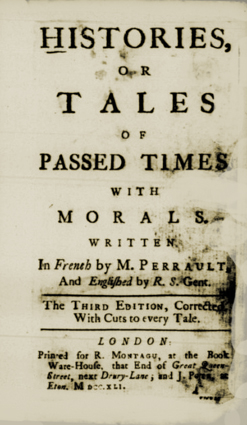
Contes /de ma mere/ l’oye./ –/ Mother/ goose’s tales./ A la haye,/ Chez Jean neaulme,/ M. DCC. XLV./
LE PETIT/ CHAPERON ROUGE./ PRETTY/ MISS RED-CAP./, S. 1-8.
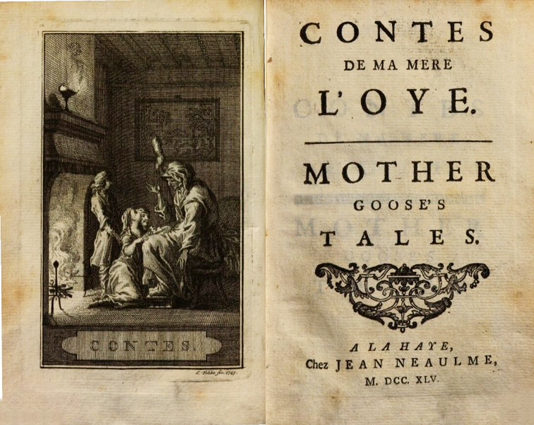
The Histories/ of Passed Times,/ or the Tales/ of Mother Goose./ With Morals;/ BY M. PERRAULT./ A new Edition, to which are added two Novels viz. The Discreet Princess, and the Widow and her two Daughters./ Adorned with fine Cuts./ Vol. I./ London printed;/ And sold at BRUSSELS,/ By B. Le Francq, Book-Seller;/ M. DCC. LXXXV.
LE PETIT/ CHAPERON ROUGE./ CONTÉ. – LITTLE RED/ RIDING-HOOD./ TALE., S. 1-11.
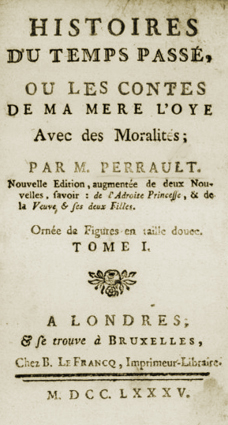
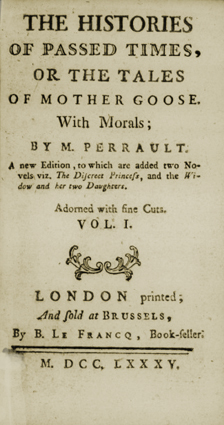
CONTES/ DU/ TEMS PASSÉ/ DE/ MA MERE L'OYE./ AVEC DES/ MORALES./ Par M. PERRAULT./ Augmentée d'une NOUVELLE, vix./ L’ADROITE PRINCESSE./ SEPTIEME EDITON./ AVEC DES JOLIES ESTAMPES./ LONDRES:/ Imprimé pour T. BOOSEY. № 4, OLD BROAD-STREET, ROYAL-EXCHANGE. 1796.
TALES/ OF/ PASSED TIMES/ BY/ MOTHER GOOSE./ WITH/ MORALS./ WRITTEN IN FRENCH// By M. PERRAULT./ AND ENGLISHED/ By R. S. GENT./ To which is added a new one, vix./ THE DISCREET PRINCESS./ SEVENTH EDITION,/ CORRECTED, AND ADORNED WITH FINE CUTS./ LONDON:/ PRINTED FOR T. BOOSEY, № 4, OLD BROAD-STREET, ROYAL-EXCHANGE, AND SOLD BY ALL OTHER BOOKSELLERS./ 1796.
LITTLE RED/ RIDING-HOOD./ TALE I. – LE PETIT/ CHAPERON ROUGE./ CONTE I., S. 1-13
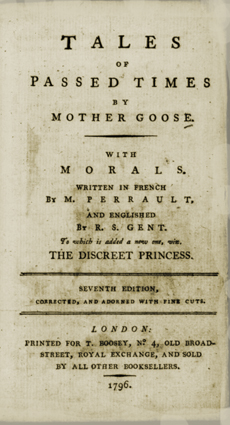
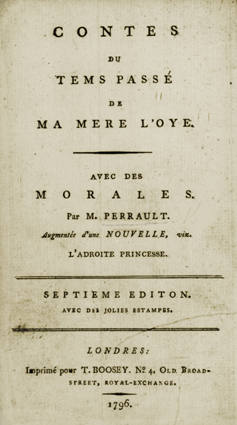
HISTORIES,/ OR/ TALES OF PAST TIMES;/ told by/ MOTHER GOOSE./ Adored with Cuts./ BRISTOL:/ Printed and Sold by Philip Rose, Broadmead./ Price Six Pence.
Little Red Riding-Hood., S. 5-9.
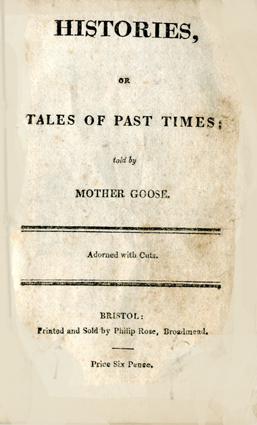
Im frühen 19. Jahrhundert brachten verschiedene Verlage „Little Red Riding Hood“ als illustrierte Chapbooks heraus; in ihnen wird die Erzählung Peraults teilweise in Versform wiedergegeben.
Als Edgar Taylor die erste Übersetzung der Grimm-Bücher ins Englische anfertigte, als German Popular Stories, translated from the Kinder und Haus Märchen, collected by M.M. Grimm, from oral tradition (London: C. Baldwyn, 1823), war “Rotkäppchen“ in der Sammlung nicht enthalten.
Edgar Taylors Übersetzungen wurden auch in einer umfangreichen Sammlung mit dem Titel Household Tales and Traditions of England, Germany, France, Scotland, etc. etc. (London: James Burns, 2 Bände, 1843-45) verwendet. […] In dieser Sammlung druckte er vierzig Märchen der Brüder Grimm ab, von denen nur zwei dem bereits auf Englisch verfügbaren Korpus hinzugefügt wurden, und zwar „Die alte Witwe“ (eine der Kinderlegenden) und „Rotkäppchen“. Charles Perraults Version des letzteren war im Englischen seit 1729 aktuell und beliebt, doch die Version der Brüder Grimm, die die Handlung mit der von „Der Wolf und die sieben Geißlein“ verknüpft und ein Happy End bietet, begann nun damit zu konkurrieren. Was wir in Burnsʼ Ausgabe jedoch haben, ist keine getreue Wiedergabe des Märchens der Brüder Grimm, sondern eine, die versucht, diese sehr seltsame Geschichte logischer und schlüssiger zu machen und dabei dem aufmerksamen Leser weitere Probleme bereitet. Rotkäppchen wird nicht vom Wolf gefressen, denn gerade als es aus dem Bett springt, um dies zu tun, schießt ein vorbeikommender Jäger auf ihn und tötet ihn mit einem Pfeil. Dann nimmt er sie mit nach Hause und ermahnt sie: „Sieh zu, dass du dein Leben lang nie wieder von der Straße wegläufst und nicht tust, was dir deine Mutter verboten hat.“ Die Großmutter wurde jedoch vom Wolf gefressen und wird in dieser Version, im Gegensatz zum Text der Brüder Grimm, nicht gerettet. Trotzdem gibt Burnsʼ Ausgabe die von den Brüdern Grimm aufgenommene Wiederholungsgeschichte wieder, in der Rotkäppchen dem Wolf ein zweites Mal begegnet und der Wolf in einen Trog fällt und ertrinkt. Aber da die Großmutter tot ist, muss sie in dieser Wiederholungsepisode durch eine Tante ersetzt werden. […]
Mitte des 19. Jahrhunderts waren die Grimms beim Lesepublikum beliebt, obwohl keine Ausgabe auch nur ein Drittel dessen abgedruckt hatte, was in Deutschland bekannt war. Doch nach den beiden Taylors, Cunningham und Thoms, war es nun möglich, eine viel umfassendere Übersetzung zu erstellen. Dies begann mit einer neuen zweibändigen Ausgabe mit dem Titel Household Stories (London: Addey & Co., 1853). Die Namen der Übersetzer werden nicht genannt, aber das Buch enthält zweihundertvierzig Illustrationen von Edward H. Wehnert und erwies sich als eine der beliebtesten Grimm-Ausgaben des 19. Jahrhunderts. Es wurde von anderen Verlegern übernommen und bis heute in verschiedenen Aufmachungen nachgedruckt.
In den zehn Jahren zwischen 1853 und 1862 wurden vier verschiedene Übersetzungen der Märchen der Brüder Grimm veröffentlicht. Neben der Übersetzung von Addey und Co. im Jahr 1853 und der von George Routledge im Jahr 1862 erschienen noch drei weitere sehr unterschiedlicher Art. Keine von ihnen enthielt mehr als etwa zwei Fünftel des gesamten Märchenkorpus, aber offensichtlich wollten verschiedene Verleger aus der Popularität, die die Märchen der Brüder Grimm nun genossen, Kapital schlagen. Die erste der drei Übersetzungen war Matilda Davisʼs Home Stories (London und New York: George Routledge & Co., 1855), die zweite die anonymen Grimms' Goblins (London: George Vickers, [1861]), die dritte Household Tales and Popular Stories (London: Ward & Lock, 1862).
Matilda Davis bietet neue Übersetzungen von 88 Märchen der Brüder Grimm, davon 91 ins Englische. Sie werden in derselben Reihenfolge wie in der Grimm-Ausgabe von 1850 präsentiert, was den Eindruck erweckt, als hätte sie eine Übersetzung des gesamten Werks angestrebt. Als ihr Verleger Routledge die Ausgabe von Addey and Co. übernahm, ging ihre Übersetzung jedoch verloren, obwohl sie 1866 und 1876 neu aufgelegt wurde. Trotzdem wurden Auszüge aus Davisʼ Werk in mehrere hauptsächlich frühe Ausgaben der Grimm-Bücher des 20. Jahrhunderts aufgenommen. Martin Sutton hält Davisʼ Arbeit aus zwei Gründen für wichtig: Sie ist die erste Frau, die auf einem Titelblatt als Übersetzerin der Grimm-Bücher genannt wird, und ihre Übersetzung setzt tatsächlich neue Maßstäbe in Bezug auf die Treue zu ihren Ausgangstexten. Obwohl ihre Übersetzungen etwas von der in der Mitte des Jahrhunderts üblichen Tendenz zur Ausführlichkeit aufweisen, zielt sie eher auf eine genaue Wiedergabe als auf eine Adaption ab. Sie ist die erste, die die gewalttätigen Details in „Rotkäppchen“, „Der Räuberbräutigam“ und „Fitchers Vogel“ genau übersetzt, und sie ist die erste Übersetzerin überhaupt, die sich an eine Wiedergabe von „Der Schneider im Himmel“ wagt und sie „Der Schneider im Olymp“ nennt. Sie löst das Problem, religiöse Themen auf humorvolle Weise zu behandeln, indem sie die Figuren Gottes und des Heiligen Petrus in Jupiter und Merkur transponiert. Es scheint schade, dass Davis' Übersetzung nicht besser aufgenommen wurde. Und auch George Thompsons Illustrationen haben dazu nicht beigetragen. Ihr Werk war nicht so kommerziell erfolgreich wie die Ausgabe von Addey and Co., die Routledge offensichtlich hatte. Verleger sind an Genauigkeit oder Treue als Werten an sich nicht besonders interessiert, wenn sie etwas anderes haben, für das sie nicht bezahlen müssen und das sich besser verkauft.
David Blamires: Telling Tales. The Impact of Germany on English Children’s Books 1780-1918. https://books.openedition.org/obp/609
HOME STORIES,/ COLLECTED/ BY THE BROTHERS GRIMM./ NEWLY TRANSLATED BY/ MATILDA LOUISA DAVIS./ ILLUSTRATED BY GEORGE THOMPSON./ LONDON: G. ROUTLEDGE & CO . FARRINGDON STREET;/ NEW YORK: 18, BEEKMAN STREET./ 1855.
Little Red Cap., S. 107-110.
